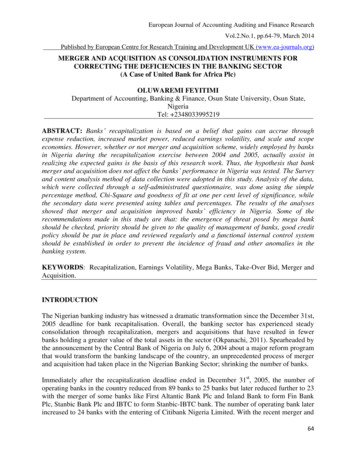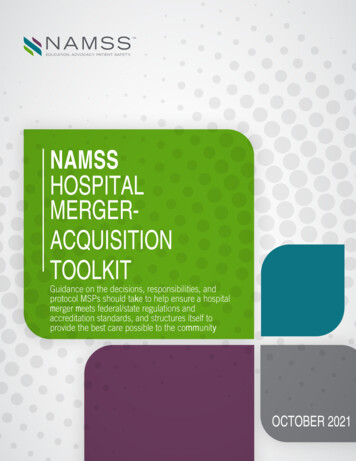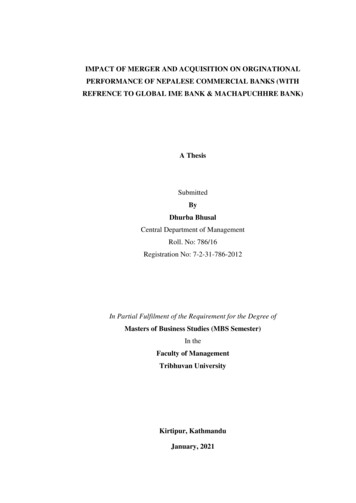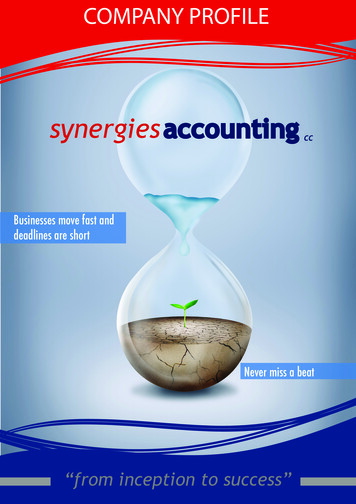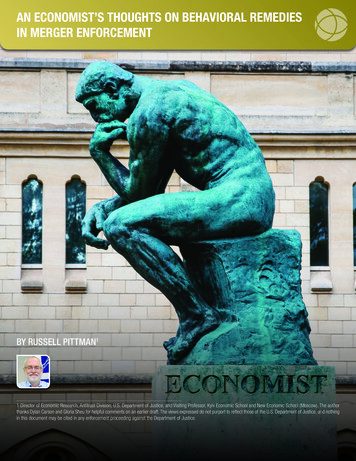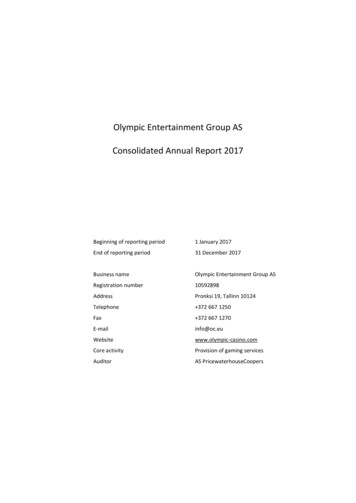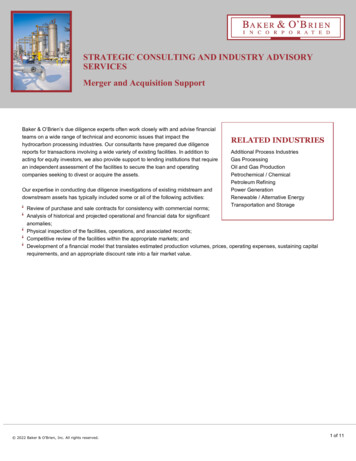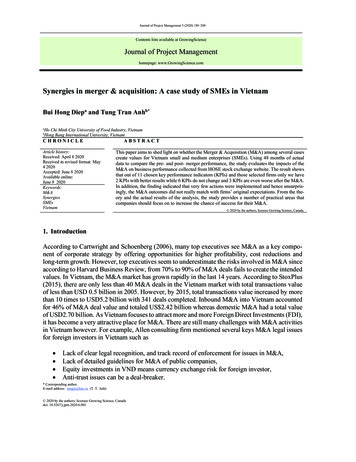
Transcription
Journal of Project Management 5 (2020) 189–200Contents lists available at GrowingScienceJournal of Project Managementhomepage: www.GrowingScience.comSynergies in merger & acquisition: A case study of SMEs in VietnamBui Hong Diepa and Tung Tran Anhb*abHo Chi Minh City University of Food Industry, VietnamHong Bang International University, VietnamCHRONICLEArticle history:Received: April 8 2020Received in revised format: May4 2020Accepted: June 8 2020Available online:June 8 2020Keywords:M&ASynergiesSMEsVietnamABSTRACTThis paper aims to shed light on whether the Merger & Acquisition (M&A) among several casescreate values for Vietnam small and medium enterprises (SMEs). Using 48 months of actualdata to compare the pre- and post- merger performance, the study evaluates the impacts of theM&A on business performance collected from HOSE stock exchange website. The result showsthat out of 11 chosen key performance indicators (KPIs) and those selected firms only we have2 KPIs with better results while 6 KPIs do not change and 3 KPIs are even worse after the M&A.In addition, the finding indicated that very few actions were implemented and hence unsurprisingly, the M&A outcomes did not really match with firms’ original expectations. From the theory and the actual results of the analysis, the study provides a number of practical areas thatcompanies should focus on to increase the chance of success for their M&A. 2020 by the authors; licensee Growing Science, Canada.1. IntroductionAccording to Cartwright and Schoenberg (2006), many top executives see M&A as a key component of corporate strategy by offering opportunities for higher profitability, cost reductions andlong-term growth. However, top executives seem to underestimate the risks involved in M&A sinceaccording to Harvard Business Review, from 70% to 90% of M&A deals fails to create the intendedvalues. In Vietnam, the M&A market has grown rapidly in the last 14 years. According to StoxPlus(2015), there are only less than 40 M&A deals in the Vietnam market with total transactions valueof less than USD 0.5 billion in 2005. However, by 2015, total transactions value increased by morethan 10 times to USD5.2 billion with 341 deals completed. Inbound M&A into Vietnam accountedfor 46% of M&A deal value and totaled US 2.42 billion whereas domestic M&A had a total valueof USD2.70 billion. As Vietnam focuses to attract more and more Foreign Direct Investments (FDI),it has become a very attractive place for M&A. There are still many challenges with M&A activitiesin Vietnam however. For example, Allen consulting firm mentioned several keys M&A legal issuesfor foreign investors in Vietnam such as Lack of clear legal recognition, and track record of enforcement for issues in M&A,Lack of detailed guidelines for M&A of public companies,Equity investments in VND means currency exchange risk for foreign investor,Anti-trust issues can be a deal-breaker.* Corresponding author.E-mail address: tungta@hiu.vn (T. T. Anh) 2020 by the authors; licensee Growing Science, Canadadoi: 10.5267/j.jpm.2020.6.001
190According to Mr. Christopher Kummer – President of Institute of M&A Association (IMAA),Swiss, the integration between the two companies post M&A is a real challenge since the twomerged companies have different strategies, culture and organization structure. In Vietnam, we cansee many issues related to M&A even between big names like Masan and Vinacafe, SHB and HabuBank, Decson and Binh Thien An, Bibica and Lotte, such as management boards of the twocompanies could not agree on business strategy after merger or management boards of the twocompanies could not agree on how the company should be run and who can make the decisions.Company like Tribeco even wanted to stop the company’s operation after the merger (Jemison &Sitkin, 1986; Sirower & Sahni, 2006).Besides, there are very limited Vietnamese literatures in this area to guide companies to implementsuccessful M&A (Vuong et al., 2009; Entezarkheir & Moshiri, 2015; Vu Anh Dung, Dang XuanMinh, 2012, Nguyen Thanh Lan, 2015). Moreover, there were many arguments arose that M&Awas neither an actual remedy for Vietnam SMEs firms to achieve the internationalization target norincrease business performance in domestic market. Using the synergy sources framework from Rosset al. (2010) and the practical M&A guidelines from KPMG (1999), the authors would like to scientifically validate these arguments. Through this example, the author also recommends an approach that other companies in Vietnam could use to improve their M&A results (Picot, 2002).2. Literature review2.1.Concept of Merger and AcquisitionMergers and acquisitions are the situation when two companies are combined to achieve strategicand business objectives (Chatterjee & Bourgeois, 2002). According to DePamphilis (2011), a merger is usually the mutual agreement by which two equal organizations merge to create a single entitywhereas an acquisition normally refers to the situation where a much bigger organization takes overa smaller one. On the other hand, Coates (2014) from Harvard Law School and Ross et al. (2010)both divide M&A into 3 types: merger or consolidation, asset purchases and stock purchases. InVietnam, M&A activities are governed by different laws including The Law on Enterprises in 2014,The Law on Investment in 2014, and The Law on Competition 2014.Types of Merger and AcquisitionsWhen two organizations are within the same industry, the merger is called a horizontal merger.Related merger is when organizations that produce or sell products that share certain commonalitiesmerge with each other (Kaplan & Norton, 1992). Mergers between organizations operating in different stages in the same value chain are categorized as vertical mergers. The target company canalso be a private company or a public company. Acquisition of public companies is often morepublicized event in the media comparing to private companies (DePamphilis, 2011; Ismail et al.,2011). There are also domestic acquisitions, in which both the acquirer and the target companiesare from the same country versus cross-borders acquisitions where the two companies come fromdifferent countries. An acquisition can also be “friendly”, in other words, meeting the desires of theseller and the buyer, versus hostile (non-friendly) when the acquiring company buying significantportion of stocks of the acquired company against the wish of the acquired company. Besides according to Martynova and Renneboog (2006), a full acquisition is when the acquirer buys 100% ofthe ownership of the target company whereas in partial acquisitions, the acquirer only buys part ofthe ownership of the acquired company (Wang & Moini, 2012).Objectives of Merger and AcquisitionsAccording to Sudarsanam, (1995), there are two different perspectives for understanding the objectives the companies have for starting an M&A: the maximization perspective of shareholders’wealth and the managerial perspective. In the maximization perspective of shareholders’ wealth,the company decision to acquire another company is fully because companies look for ways to
B. H. Diep and T,T.Anh / Journal of Project Management 5 (2020)191maximize the wealth of the shareholders. The maximization of the value of the shareholder takesplace when the net present value of the investment is positive. The second perspective is the managerial perspective for conducting an M&A, which focuses more on the motives of top executives inthe company. These can be varied such as growth reasons, to use previous underemployed abilitiesand skills, risk diversification (Ansoff, 1958) and to evade being the ones being taken over.2.2.SynergyAccording to Burney (2008), the “Synergy” word originates from Greek and it means to work together. Synergy has been explained as “the whole is greater than the sum of its parts” or put itsimply 1 1 3 (Sherman, 1998). In M&A, synergy can be explained as - If ‘Company A’ mergeswith ‘Company B’, the value of merged entity called ‘Company C’ should be greater than the sumof the values of Company A and Company B (Johnson et al., 2015).{V(1) V(2)} V(3) Where:V(1) Independent Value of Company A,V(2) Independent Value of Company B,V(3) Value of Merged Entity – Company B Synergy V V(3)- (V(1) V(2))Various empirical studies show the successes or failures of merged companies. Petitt and Ferris(2013) in their study on M&A and synergy found that when two companies enters into an M&Atransaction and synergies are apparent between them then there is high potential that value will becreated and the M&A can be a success. Grinblatt and Titman (2004) also suggest companies shouldonly pursue an M&A if the value of the acquirer and the target company when they operate as asingle company is greater rather than sum of the values that individual ones can bring when operateindependently. Godbole (2013) argues that Merger and Acquisition values actually come from synergy and for an M&A to create its intended values, company management must find a way to createsynergies between the two companies in the post-merger, integration phase. Not only the academicbut also the major consulting companies talk about the same. For example, KPMG in its “Synergies:A business guide report” in 2011 also emphasized that “without synergies, an M&A is unlikely toresult in any significant incremental shareholder value”. According to KPMG (2001), synergies arevery important in M&A as 1) It directly impacts the bidder price where normally, bidders wouldneed to pay a premium to the acquiring company and this premium is normally calculated based onthe additional values or synergies that the bidders think it can get from the deal. 2) Synergy is keyto form the message that the successful bidder will make to deliver an effective communication tothe stock market about the M&A and 3) Synergy is also key for successful bidder to form a messageto get buy-in from managers and employees of the acquiring and acquired companies.Sources of synergyAccording to Mallikarjunappa and Nayak (2007), synergies might come from more efficient management, improved production techniques, economies of scale and scope, redeployment of assets,resources combination or the exploitation of market power or any number of values enhancingmechanisms. According to Ross et al. (2010), value synergies is based on the incremental cash flow,which is the change in cash flow of the combined firm and the sum of the cash flow for two firmsconsidered separately. Synergy CF CF(3)- ( CF(1) CF(2) )
192 CF EBIT Depreciation - Tax - Capital requirement Revenue- Cost - Tax - Capital requirementwhere: Revenue, Cost, Tax respectively are the difference in the revenue, cost, tax of the combined firm versus the sum of the cash flow for two separate firms. Capital requirement is thechanges of fixed assets and net working capital. Consequently, Ross et al. (2010) suggested thatM&A synergy can be categorized into four main types as shown in below figureCostReductionLower TaxesRevenueEnhancementReductions inCapital NeedsSYNERGYFig. 1. Sources of synergy2.2.1. Revenue enhancementIncreased revenue can come from using shared distribution channel or media or sales forces to sellfor the products and brands of both the acquiring and acquired companies. With an increased marketshare, mergers can increase the market power of the acquiring company as it has more controls onprices or quantities within the market and thus increase the revenues. Vertical integration can alsoresult in higher market power by increasing entry barriers and lowering input costs for the firm.(Sudarsanam, 2006-2007; Faulconbridge et al., 2008; Galpin & Herndon, 2000; Srivastava & Datta,2002).KPMG (1999) mentioned in their “Mergers and Acquisitions: Global Research Report” that “synergies are vital to the success of any merger or acquisition without them, an M&A is unlikely toresult in any significant additional growth in shareholder’s value”. They urge companies going intoM&A to have a clear understanding of what and where value can be obtained in revenue. Based onKPMG survey (1999) on over 700 cross border deals between the 2 years from 1996 to 1998, companies can actually focus on the following factors to increase revenue like in figure 4 : New market,new customer, cross-selling, marketing, sales force, new product, improved customer services, newdistribution channels.
B. H. Diep and T,T.Anh / Journal of Project Management 5 (2020)193New customersNew marketsMarketingNew product developmentCustomer services and back-upAccess to new distribution channelsSales force efficiencyCross selling0%5%10%15%20%25%30%35%40%45%50%Fig. 2. Areas for increasing revenue2.2.2. Cost reductionCost reduction involves streamlining the combined operations in such a manner that by joiningfunctional activities, the acquirer and acquiring companies can reduce costs by avoiding duplicationin marketing, research and development as well as optimize costs related to sales, human resource,Finance, Admin and other overhead costs. Operational cost synergies in terms of economies of scalecan also be achieved by spreading the fixed costs over increasing production volumes and hencelowering the average unit cost. Besides, a merger can also help to reduce excess capacity and theacquirer can therefore, adjust supply levels to match demands to optimize costs. Last but not least,merger can also lead to a stronger buyer power to lower input prices (DePamphilis, 2011; Marks &Mirvis, 2010). By reducing costs the combined firm can improve its margins and thereby boostprofits given that the price and sales volumes are unchanged. For example, in the airline industry,when Kingfisher Airlines acquired Deccan Airways and Jet Airways acquired Sahara Airlines, bothwere expecting to achieve substantial savings through operations synergies such as reduction in thecombined number of flights on the same routes, sharing of commercial and ground handling staff,rationalization of routes, reduction in the combined number of airplanes in use and so on (Gupta,2012; Dringoli, 2016; Grotenhuis, 2009; Sevenius, 2003). Similar to synergy in revenue, KPMG(1999) also reports the key areas for potential cost synergies that companies can get from the following factors: Headcount reductions, buying and merchandising, supply chain, procurement, manufacturing, warehousing and distribution, new product development, R&D in Fig. 3. These factorsare chosen and also grouped into 5 main factors as below:Head count reductionsBuying and merchandisingSupply ionNew product developmentR&DOther0%10%20%30%Fig. 3. Areas for saving cost40%50%60%70%
1942.2.3. Lower taxesAccording to Gupta (2012), tax synergy might occur when merging a loss-making company with aprofitable one so that the merged company can write-off accumulated losses of the loss-makingcompany against the profits of the profit-making company. Tax synergy can also arise in crossborder M&A, when the combined company might take the opportunity to optimize their tax pay byallocating more works and costs to the new country should the tax rate is lower there. According toAuerbach and Reishus (1987), there are clear tax benefits available at the corporate level in the formof stepped-up asset bases and the increased utilization of tax losses and tax credits. Even at stakeholder level, tax benefits might be available through an M&A deal for example, shareholders ofacquired companies might receive payments when selling their shares which are at a much lowertax rate than the stakeholders normal income tax rate or even in some cases non-taxable (Auerbach& Reishus, 1987)2.2.4. Reductions in capital investmentM&A can help to reduce the combined investment needed by the two firms According to Gupta(2012), reduction in capital investment synergy involves combining both the acquirer and targetcompanies’ Balance sheets to achieve a better gearing ratio or a reduction in the weighted averagecost of capital (WACC). Companies can create value through merger and acquisition by investingthe capital they raise from investors to generate future cash flows (Koller, 2009). This financialsynergy through mergers and acquisitions can help to lower the cost of capital and therefore,increase company value. In unrelated acquisition, the acquirer can acquire another company withun-related cash flows and thereby reduce risk by diversifying their financials (Schall & Higgins,1975). Mewes (2015) also suggests smaller companies generally have to pay a premium whenborrowing money relative to larger companies however, when two mid-sized companies merge,they can lower their combined cost of capital more than they could individually. An example is themerger of Reliance Petrochemicals Limited (RPL) with the Reliance Industries Limited (RIL) in1991-92 by “lowering the cost of capital so as to allow them to invest in capital intensive projectswith various refineries” (Gupta, 2012; Haspeslagh & Jemison, 1991).3. MethodologyThere are two common research approaches, i.e. quantitative vs. qualitative and this research usesboth research approaches in order to insights into the M&A deal among SMEs in Vietnam. In quantitative method, First, the author collects financial performance data from audited financial statements as well as from various internal management reports. Data during the 4 period from 2014 to2018 were collected to compare the performance before and after M&A. The author runs a pairedsample T-test on these data to validate if there was any significant change in SMEs performancebefore and after the M&A. Due to confidentiality; a number of data presented in this thesis has beennormalized reason show only the percentage comparison to a base year before M&A. Second, theauthor also performs in depth interviews with key personnel in selected firms. In-depth interviewsare personal and unstructured and aim to identify the participant’s emotions, feelings, and opinionsabout the M&A. The author also used content analysis, which is the type of research where gathereddata is categorized in themes and sub-themes so that they can be compared (Moore et al., 2006), toanalyze the interviewed data. An advantage of this data analysis approach is the data collected couldbe simplified and reduced, while at the same time producing results that may then measure usingquantitative techniques. On the other hand, Qualitative Research is primarily exploratory. It is usedto understand underlying reasons and motivations. It helps to provide problem insights into theproblem or develop hypotheses for potential quantitative research. In contrast to quantitative analysis, qualitative outcomes are normally not quantifiable or measurable. Qualitative analysis is moreappropriate for small data samples situation. Its advantage is that “it offers a complete descriptionand analysis of a research subject, without limiting the scope of the research and the nature of
B. H. Diep and T,T.Anh / Journal of Project Management 5 (2020)195participant’s responses” (Collis & Hussey, 2003). However, because the outcomes of qualitativeresearch can be based on from researcher’s personal judgments and interpretations therefore, adrawback of this research approach is the quality is heavily based on the skills and abilities of researchers. Also, according to Bell (2005), there are risks that the results of qualitative research mightnot reflect all the opinions of a wider population as the approach is more appropriate for small datasample. In this paper, qualitative method is used to clarify the concepts like M&A and synergy aswell as to analyze the M&A case.4. FindingsThe author runs a paired sample T-test on the data to validate whether there was any significantchange in performance after the M&A. The significance level is higher than 0.05, by conventionalcriteria, this difference is considered to be not statistically significant where as if the significance issmaller than 0.05, this difference is considered to be statistically significant.4.1. Result of Synergy indicatorsRevenue enhancementThose table below illustrated the pair-sample T-test of revenue enhancement after M&ATable 1Paired sample T-test SMEs revenue growthPair 3 Growth 1 - Growth 2MeanStd.Deviation9.08%0.27%Paired DifferencesStd. Error95% Confidence Interval of 01tdfSig.(2-tailed)3.57823.5620tdfSig. 6Table 2Paired sample T-test SMEs revenue per employeePair 11Rev 1 - Rev 2MeanStd.Deviation0.0015-0.0076Paired DifferencesStd. Error95% Confidence Interval of Table 3Paired sample T-test SMEs customer satisfactionPair 6SAT 1 - SAT 2MeanStd.Deviation4.24321.0713Paired DifferencesStd.95% Confidence Interval of theError MeanDifferenceLowerUpper.52493.89166.0398Table 4Paired sample T-test SMEs ROEPair 1ROE 1 - ROE 2MeanStd.Deviation- 0.45%0.17%Paired DifferencesStd. Error95% Confidence Interval of ble 5Paired sample T-test SMEs ROAPair 2ROA 1 - ROA 2MeanStd. Deviation-0.03547%0.42407%Paired DifferencesStd. Error95% Confidence Interval of 0%
196Cost reductionThe below indicators were used to analyze whether firms achieved cost reduction synergies afterM&ATable 6Paired sample T-test SMEs Gross ProfitPair 4GPM 1 - GPM 2MeanStd.Deviation-1.02043%1.99942%Paired DifferencesStd. Error95% Confidence Interval of 15%tdfSig. dfSig. able 7Paired sample T-test SMEs EBIT/SalesPair 7E/S 1 - E/S 2MeanStd.Deviation-0.08027%1.77714%Paired DifferencesStd. Error95% Confidence Interval of 5%Table 8Paired sample T-test SMEs Operating RatioPair 8O/P 1 - O/P 2MeanStd. Deviation-1.04907%1.55299%Paired DifferencesStd. Error95% Confidence Interval of 29%Reduction in capital needsTable 10Paired sample T-test SMEs Debt-to-EquityPair 5DEB 1 - DEB 2MeanStd.Deviation0.9792.2025Paired DifferencesStd. Error95% Confidence Interval of theMeanDifferenceLowerUpper.0408.89471.0636Table 11 summarizes the results of paired sample t-test results on the 10 KPIs for SMEs performance before and after M&ATable 11The summary of synergy indicators before and after M&A - Pair sample t-test resultsNumber12345678910AreaRevenue enhancementCost reductionReduction in capital needsIndicatorsRevenue growth rateRevenue per employeeCustomer satisfaction scoreCustomer survey on M&A dealROAROEGross profitOperating Ratio: Opex cost / SalesEBIT / SalesDebt to equity ratioResultsWorstNo changeNo changeNo changeNo changeNo changeBetterNo changeWorstBetterIt can be seen from the results of the quantitative analysis in the previous section that those selectedfirms achieved no revenue increment synergies (out of 6 KPIs, 1 KPI worse and 5 KPIs unchanged)and very little cost reduction in synergy (Out of 3 KPIs, 1 KPI better, 1 KPI unchanged and 1 KPIworsen). Our hypothesis is that firms got this result because they haven’t done much in terms of
B. H. Diep and T,T.Anh / Journal of Project Management 5 (2020)197creating synergy in this M&A and we will validate that based on the sources of synergy frameworkand the KPMG practical guideline explained in literature review part.5. Conclusion and RecommendationAs can be seen from the quantitative and qualitative analysis, we can see that those cases of M&Aare far away from meeting the original expectations that the two companies have. The key reasonsare because they haven’t done much in term of synergy creation both:-Pre M&A: No planning on how to create synergies from the M&AAfter M&A: Limited actions to create synergies in almost all potential areas.Companies can use the sources of synergy as a framework to review integration process in M&Adeal, a demonstration of how this could be done is shown with the SMEs case study.Consulting firms like KPMG suggest that companies should set up a cross functional project teamto plan then execute the plan following M&A annoucement to realise synergies (KPMG 2009).Integration project planning and execution should go hand in hand with synergy evaluation as a keyto merger success. Through project plan, companies should work out exactly how synergies will beattained, and also how the combined business will be stabilized to preserve current value. KMPGreports that companies prioritized pre-deal integration project planning are 13% more likely thanaverage to have a successful deal. Companies should remember they only have a ‘honeymoon’period of some 100 days after deal completion to take hold of the business and begin realizingbenefits.The author strongly recommends that SMEs to setup a project team to implement required actionsto create synergy. They should first review the different areas of synergies to see which ones aremore relevant for them. The author recommends the below 4 areas as the most relevant andvalueable for SMEs to focus on first due to their potential values as well as the easiness toimplement:a. Redudant positions: Although this is a very people sensitive activity, with determination,SMEs’s management can implement this quite quickly as compared to other areas ofsynergy opportunities. SMEs management should note that they might never satisfy allstakeholders wishes but they need to ensure all the views from different stakeholders aretaken into consideration i.e. Central Group owner, SMEs owner, management staffs,employees etc. For impacted stakeholders, actions should be planned upfront to minimiseimpacts on the overall project.b. Sourcing consolidation: This is also another easy area for SMEs to look in to. They can forma centralised Sourcing team to review and compare all category of spending in both SMEsand Central Group Vietnam companies in order to consolidate and generate savings fromoptimising these spendings. In term of product procurement, SMEs should combine withCentral Group when negotiating with product vendors such as Samsung, LG, Sony, etc for a lower price. This could be a competitive advantage for SMEs compared to othercompetitors in Vietnam market, who don’t have such a big partner to increase its negotiationpower.c. Rationalize distribution centers: In the current electronic home appliance market inVietnam, SMEs should continue to invest to open new stores in appropriate new locationsif they don’t want to be beaten by competitors like thegioididong. Additional capitals fromM&A should be utilized instead of keeping idle. They should also continue to collaboratewith other Central Group subsidiaries like BigC Vietnam to get the best location for itsstores.
198d. Back-office consolidation: SMEs should look at re-engineering business process from endto-end to not only remove duplicated processes but also to take advantages of the bestpractices from the two companies. This is a big, challenging project but if implementedsuccessful, would bring significant values for SMEs.ReferencesAllen consulting (2016). Ten key M&A legal issues for foreign investors in Vietnam. A-170629.pdfAnsoff, H. I. (1958). A model for diversification. Management Science, 4(4), 392.Atradius (2016) at herman, A. J. (2005). Mergers and Acquisitions from A to Z (2nd ed). Saranac Lake:AMACOM.Burney, A. (2008). Inductive and deductive research approach. Department of Computer Science,University of Karachi, Pakistan, 22.Cartwright, S., & Schoenberg, R. (2006). 30 years of mergers and acquisitions research: Recentadvances and future opportunities. British Journal of Management, 17(S1), S1-S5.Chatterjee, S., & Bourgeois, L. J. (2002). A Framework for Acquisition Success: Post-AcquisitionResource Interactions. Batten Institute, Darden Graduate School of Business, University Of masynergies/Deloitte (2016). Retail in Vietnam Emerging market, emerging growth. athttp://www.iberglobal.com/files/2016/vietnam retail.pdfDeloitte (2015). Integration Report 2015 Putting the pieces together. 2015.pdfDePamphilis, D. (2011). Mergers, acquisitions, and other restructuring activities: An integratedapproach to process, tools, cases, and solutions (5th Edition). Amsterdam: Academic Press.Dringoli, A. (2016). Merger and Acquisition Strategies: How to Create Value. Edward Elgar Publishing.Entezarkheir, M., & Moshiri, S. (2015). Merger induced changes of innovation: Evidence from apanel of US firms. Unpublished paper, Huron University College, Western University.Faulconbridge, J., R., Hall, S., & Beaverstock, J., V., (2008). New Insights into theInternationalization of Producer Services: Organizational Strategies and SpatialGalpin, T. J., & Herndon, M. (2000). The complete guide to mergers and acquisitions. SanFrancisco: Jossey-Bass Publishers.Godbole, P. G. (2013). Mergers, acquisitions and corporate restructuring. Vikas Publishing House.Grinblatt, M., & Titman, S. (2004). Financial markets and corporate strategy. Mc Graw Hill.Grotenhuis, F. D. (2009). Mergers and acquisitions in Japan: Lessons from a Dutch‐Japanese casestudy. Global Business and Organizational Excellence, 28(3), 45-54.Gupta, P. K. (2012). Mergers and acquisitions (M&A): The strategic concepts for the nuptials ofcorporate sector. Innovative Journal of Business and
This paper aims to shed light on whether the Merger & Acquisition (M&A) among several cases create values for Vietnam small and medium enterprises (SMEs). Using 48 months of actual data to compare the pre- and post- merger performance, the study evaluates the impacts of the M&A on business performance collected from HOSE stock exchange website.
